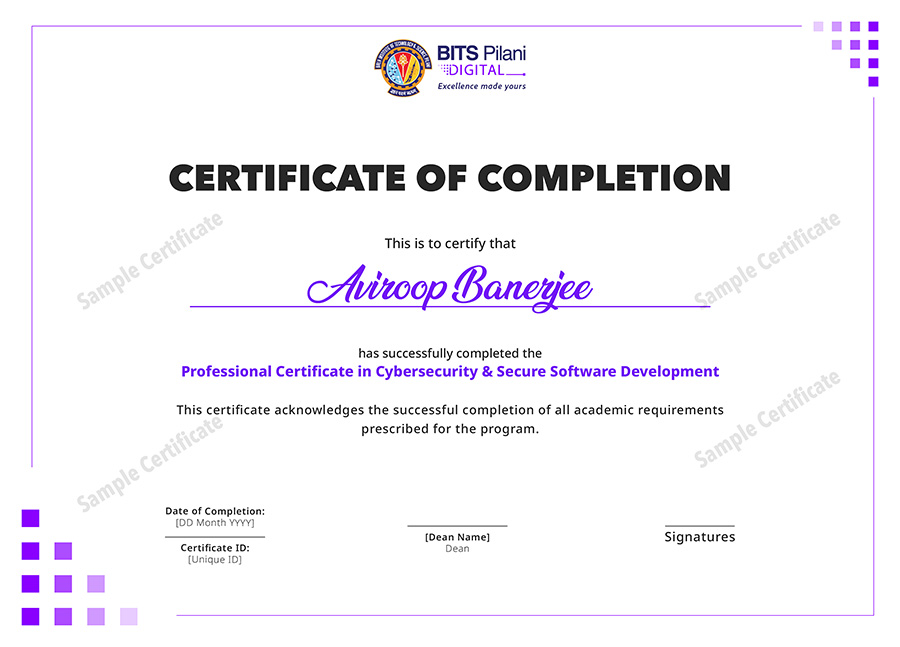Duration
35 weeks
Admission Deadline
15th Dec, 2025
(Jan 2026 Batch)Fees
INR 1,25,000 (+ GST)
Easy EMI option availableType of Program
Certificate
Program Introduction
In today’s hyperconnected world, every application you build faces a growing wave of cyber threats. Yet, most cybersecurity efforts still focus on defense after the fact — patching vulnerabilities instead of preventing them.
The Professional Certificate in Cybersecurity and Secure Software Development, co-created by BITS Pilani Digital and leading industry practitioners, empowers developers to build secure systems that can withstand modern threats.
Unlike conventional cybersecurity programs that focus on IT infrastructure or post-attack recovery, this program teaches you to embed security into your software design and development process itself — ensuring that every line of code you write is resilient by design.
This program combines the academic excellence of BITS Pilani with the hands-on expertise of cybersecurity professionals who’ve defended enterprise systems, designed secure architectures, and led real-world cyber response teams.
The BITS Pilani Digital Cybersecurity Certificate Program is your chance to join that elite league. In just 35 weeks, you’ll master the full stack of cybersecurity through real-world simulations, 20+ industry tools, and a virtual clean-room environment designed for hands-on mastery.
Because in a world that needs smarter defense and stronger code, those who learn deeper, rise higher.
Lead the Next Wave of Cyber Defense
India’s cybersecurity market is projected to grow at over 20% CAGR, yet there’s a significant talent shortfall in secure software development.
As organizations accelerate digital transformation, the demand for professionals who can both develop software and secure it is soaring.
This program bridges that gap by training professionals to think like developers and act like defenders — mastering both the engineering mindset and the cybersecurity toolkit.
You’ll gain practical, project-based skills that are immediately applicable to roles in application security, cloud defense, data protection, and threat management.
(Source: Grand View Research)
The BITS Edge
Learn deeper with BITS Pilani’s academic depth. Rise higher to lead the next wave of cybersecurity innovation.
Traditional cybersecurity programs teach professionals to react only after threats strike. And yet, security should not be bolted on—it should be built in.
LEARN DEEPER,
RISE HIGHER
Learn how to write, test, and deploy secure code across modern frameworks and environments.
Understand common vulnerabilities, from injection attacks to insecure APIs, and apply secure development practices that prevent them.
Develop the mindset to build software that’s not just functional — but inherently safe.
Traditional certification-style training doesn’t create defenders. Experience does. Because you don’t learn to defend by reading about attacks. You learn by defeating them.
LEARN DEEPER,
RISE HIGHER
Move beyond passive lectures to solve real-world cybersecurity problems. Each of the seven projects in the program focuses on a different class of cyber threat — from application-layer exploits to cloud and AI-driven vulnerabilities — helping you build hands-on mastery through discovery and resolution.
Security isn’t a patch. It’s a property of every layer. Yet most programs only touch the surface of secure coding by teaching isolated principles or focusing on a single layer of application security.
LEARN DEEPER,
RISE HIGHER
Gain a 360° view of cybersecurity across the entire technology stack — data, application, and infrastructure.
From cryptography and secure coding to container security and AI-based threat detection, you’ll learn to secure every layer of software development and deployment.
By the end of the program, you’ll be able to design, build, and protect applications from the ground up.
In cybersecurity, experience matters most. But real defense needs a safe environment to practice.
LEARN DEEPER,
RISE HIGHER
Work hands-on in a safe, virtual environment built to simulate real cyberattack and defense scenarios.
Here, you can experiment with tools, study threats, and test your countermeasures without endangering your own systems.
This clean-room environment ensures practical, risk-free learning — allowing you to truly experience what it means to defend digital systems in real time.
In the world of secure software, passing tests doesn’t prove mastery. Solving real problems does.
LEARN DEEPER,
RISE HIGHER
No exams. No rote tests.Your progress is measured through seven real-world cybersecurity projects, each focused on solving a practical problem.
These projects not only solidify your learning but also build a tangible portfolio of evidence — demonstrating your skills, problem-solving approach, and readiness for industry roles.
Most cybersecurity programs focus either on theory alone or purely practical workshops.
LEARN DEEPER,
RISE HIGHER
Learn under the combined mentorship of professors and senior industry practitioners.
This dual approach blends academic rigor with professional insight — giving you conceptual depth, technical expertise, and an understanding of what organizations really look for in cybersecurity professionals.
Every live session and project is guided by experts who’ve built, broken, and secured systems at scale.
No learner should walk alone. Growth happens with the right balance of independence and guidance.
LEARN DEEPER,
RISE HIGHER
The program ensures industry readiness through mentorship, visibility, and confidence-building.
You’ll receive:
- Career Mentorship: Guidance from experts on presenting your projects and professional profile.
- Partner Network Access: Curated opportunities through BITS Pilani’s extended ecosystem.
- Interview Navigation: Support in understanding selection processes and technical evaluation.
Disclaimer:
BITS Pilani Digital equips learners with industry-relevant skills and career support to enhance employability. However, job placement or advancement is not guaranteed. Opportunities depend on market conditions, learner performance, and individual goals. Learners are expected to take ownership of their career growth and actively apply what they learn.
Eligibility Criteria
If you’re ready to move from building applications to protecting them, this program will help you make that leap.
Applicants with a Bachelor’s degree and experience in software development or IT infrastructure management can apply. A background in programming (Python, Java, C++, or equivalent) is expected.
The program is best suited for professionals with 2+ years of experience in software development or IT infrastructure management , though motivated applicants with less experience may also apply if confident in handling the advanced, practice-oriented curriculum.
Prerequisite Advisory
This is an intensive, hands-on program designed for serious technical professionals/developers. While this advisory is not an eligibility requirement, learners are expected to have basic familiarity with programming concepts and logical problem-solving to fully benefit from the experience.
No advanced mathematics is required — foundational school-level analytical readiness is sufficient. Prior exposure to any programming or scripting language will help learners accelerate their learning journey.
Offer of admission would be based only on BITS Pilani Digital- Admission Cell`s assessment of the overall application which includes the prior educational details, work exp information and other information submitted in the application form.
Master 25+ Industry Tools That Will Power Your AI Career




























Learning Methodology
This program uses problem-based learning, an approach proven to build deep, applied understanding. Each week introduces a new threat scenario, which you’ll tackle using specific frameworks, tools, and defense strategies — supported by guided mentorship and peer collaboration.
This is not passive learning — it’s structured problem-solving that mirrors real cybersecurity workflows.
Turn the cybersecurity boom into your breakthrough.
CAREER
IMPACT
DASHBOARD
Secure systems.
And your place at the top.
Turn Skills Into Careers
The deeper you learn to defend, the higher your career ascends.
Role |
Earning Potential* |
What You’ll Do |
| Cybersecurity Analyst | ₹ 5-8 LPA | Monitor security systems, analyze threats |
| SOC Analyst | ₹ 5-8 LPA | Security monitoring, incident triage |
| Junior Penetration Tester | ₹ 6-10 LPA | Vulnerability assessment, security testing |
| Application Security Engineer | ₹ 7-12 LPA | Secure code review, DevSecOps |
*Source: 6figr, Indeed, SOC Masters, GeeksforGeeks, Sharpener
Role |
Earning Potential* |
What You’ll Do |
| Security Engineer | ₹ 8-15 LPA | Security architecture, system hardening |
| Incident Response Specialist | ₹ 10-18 LPA | Breach investigation, forensics |
| Cloud Security Engineer | ₹ 10-16 LPA | Multi-cloud security implementation |
| Cybersecurity Consultant | ₹ 12-20 LPA | Risk assessment, compliance auditing |
*Source: 6figr, Indeed, SOC Masters, GeeksforGeeks, Sharpener
Role |
Earning Potential* |
What You’ll Do |
| Security Architect | ₹ 15-30 LPA | Enterprise security strategy, design |
| CISO/Security Manager | ₹ 25-50 LPA | Security program leadership |
| Principal Security Engineer | ₹ 20-35 LPA | Advanced threat research, innovation |
| Cybersecurity Entrepreneur | Unlimited potential | Security product/service ventures |
*Source: 6figr, Indeed, SOC Masters, GeeksforGeeks, Sharpener
*Source: 6figr, Indeed, SOC Masters, GeeksforGeeks, Sharpener
This information is based on publicly available sources, and individual experiences may vary depending on multiple factors.
Industry Demand Snapshot
India’s cybersecurity
workforce shortfall exceeds
professionals,
particularly in secure
software development.
Cybersecurity spending in India is
expected to reach
by 2025,
driven by demand for application
security and cloud security.
Professionals with secure coding and
full-stack cybersecurity skills command
higher salaries
than their peers.
Curriculum Snapshot
Understanding the Digital Threat Landscape
This module introduces the foundations of cybersecurity, key terminologies, industry threats, and best practices. It covers the CIA triad, cybersecurity domains, roles, and standards, while also providing real-world industry applications. Learners gain exposure to recent incidents and hands-on activities like firewall configuration and phishing simulations.
Mapping Vulnerabilities and Attack Pathways
This module introduces learners to the principles of threat modelling, multi-step attack models, malware lifecycle, security testing, and incident response. It emphasizes early identification of threats in the development lifecycle, frameworks like STRIDE, ATT&CK, and NIST guidelines, and explores real-world case studies such as Log4j, Equifax breach, and WannaCry. Learners will engage in simulations, malware analysis, and hands-on incident response exercises.
Safeguarding Data and Communications
It covers classical and modern encryption techniques (AES, RSA, ChaCha, Diffie-Hellman), hashing and message authentication, as well as authentication, digital signatures, and non-repudiation. The module further explores network security protocols (TLS/SSL, IPSec), access control models, logging and monitoring, and the principles of zero-trust architecture.
This module focuses on secure engineering principles, secure coding practices, and the use of industry frameworks like OWASP to build resilient applications. It explores common vulnerabilities (SQL injection, buffer overflows, XSS, CSRF, insecure deserialization), language-specific coding issues, and security testing techniques (overview of SAST, DAST, penetration testing). Learners will gain practical exposure to security testing tools, vulnerable applications, and the role of GenAI in secure coding.
This module provides an understanding of how to secure data across stages, from creation and storage to transmission. Learners will explore the concept of data security and their threats, risks and the key data security concepts such as encryption, access control, authentication, and data classification. It introduces the industry best practices, and common security standards that guide organizations in safeguarding sensitive information. It provides exposure to widely used tools (such as encryption software, data loss prevention systems, and secure file transfer mechanisms) that will help the learners with hands-on insights.
Tools, Techniques, and Trends
This module introduces learners to the core principles of AI, ML in cybersecurity, it teaches how intelligent algorithms can identify, classify, and respond to digital threats. Learners will gain hands-on experience with open-source ML frameworks, learn to design models for malware and phishing detection, and understand how AI supports proactive threat hunting and automated defense strategies.
This module focuses on strengthening security within cloud environments across IaaS, PaaS, and SaaS models. Learners will explore common challenges such as service misconfigurations, risks in shared responsibility, and compliance gaps.
Emphasis will be placed on hardening cloud infrastructure by implementing network segmentation, encryption, and resource isolation, alongside securing containerized and serverless applications as well as cloud storage buckets. To improve visibility and control, the module highlights the importance of logging, monitoring, and automated compliance tools such as AWS Config, AWS Inspector, Terraform, and CSPM platforms. It also covers detection and mitigation of threats like DDoS attacks, using advanced anomaly detection tools (e.g., AWS GuardDuty).
Finally, learners will gain hands-on experience in security provisioning, configuration, and automation using scripting and tools like Python, Ansible, and Terraform to enforce consistent security practices.
Learn from the leaders of AI
Sample Certificate

FEE STRUCTURE
INR 1,25,000 (+ GST)
(included in total program fee)
INR 14,750
(inclusive of GST)(one time)
INR 1,500
While many labs use shared or open-source environments,
some advanced modules require enterprise cloud access. The associated usage costs are learner-funded.

The most asked questions
BITS Pilani Digital is the Digital Learning Division of BITS Pilani, one of India’s most respected and future-driven institutions. It offers a range of rigorous, industry-aligned upskilling programs for technology professionals who want to stay at the forefront of innovation and continuously grow with the evolving digital world.
By combining BITS Pilani’s academic excellence with hands-on, practice-oriented learning, BITS Pilani Digital enables professionals to strengthen their expertise, advance their careers, and stay future-ready,without stepping away from their current roles.
The Professional Certificate in Cybersecurity and Secure Software Development is built for technology professionals who want to design and defend secure applications, systems, and infrastructure through real-world problem-solving. It combines academic rigor with deep industry integration, enabling learners to gain practical mastery in secure coding, DevSecOps, cloud security, and AI-driven defense mechanisms.
Distinctive features of this program include:
- Layered Security Learning: Covers application, data, cloud, and runtime layers through simulated attacks and defenses.
- Clean Room Environment: Learn and practice in an isolated cybersecurity lab designed for real exploit-and-defend simulations.
- Problem-Based Learning (PBL): Engage in seven progressively challenging projects, each centered on a real-world cyber threat scenario.
- Dual Mentorship Model: Learn from BITS Faculty and industry professionals who actively secure enterprise-grade systems.
- Hands-on, Project-Based Evaluation: Every module integrates real-world projects and labs, and learners are assessed entirely on demonstrated skills,evaluated by what they build, secure, and deploy rather than through traditional exams.
This program is designed for technology professionals who want to build practical, end-to-end expertise in cybersecurity and secure software development.
It is ideally suited for:
- Software Developers, Full Stack Engineers, and DevOps Engineers looking to strengthen their security expertise.
- Technical Infrastructure or Security Engineers aiming to deepen their application-security and secure-coding capabilities.
- Professionals aspiring for roles such as Secure Software Engineer, DevSecOps Engineer, or Cloud Security Specialist.
While the program assumes basic familiarity with programming or scripting (e.g., Python, JavaScript, or Shell), all concepts are introduced progressively through guided projects and mentorship. It is best suited for professionals with two or more years of experience in software development or IT infrastructure management.
Applicants holding a Bachelor’s degree and possessing relevant professional experience in software development or IT infrastructure management are eligible to apply for this program. Candidates are also expected to have a background in programming or scripting, such as Python, Java, or C++ (or equivalent).
While the program is open to all eligible applicants, it is best suited for professionals with two or more years of work experience in software development or IT infrastructure management. Applicants with less than two years of experience may also apply; however, they are advised to do so only if confident in their ability to fully leverage the program’s advanced and practice-oriented curriculum.
Note:
Offer of admission would be based only on BITS Pilani Digital’s Admission Cell’s assessment of the overall application, including CV, educational background, work experience, and other details submitted in the application form.
Yes. Applicants should have a basic understanding of programming or scripting (such as Python, Java, or C++) and professional experience in software development or IT infrastructure management.
While the program introduces cybersecurity concepts from the ground up, it’s designed for professionals who already understand technical workflows and want to apply them in real-world security contexts.
The program runs for approximately 35 weeks (about 8.5 months).
It comprises 7 problem-based learning modules, each focused on a unique cybersecurity threat class, progressing from application-layer exploits to cloud and AI-driven vulnerabilities.
Weekly learning structure:
- ~3+ hours of recorded digital learning modules
- ~6 hours of hands-on labs and project work
- ~2 hour of live mentor-led sessions for insights and discussions
Expect around 9–10 hours of total engagement per week, optimized for working professionals balancing their jobs with advanced learning.
The program provides exposure to over 20 industry-relevant tools, including: OWASP ZAP, Burp Suite, Metasploit, Wireshark, Terraform, GuardDuty, Splunk, Docker, Kubernetes, Jenkins, SonarQube, and Trivy, among others , all used for building, testing, and securing modern applications and infrastructure.




